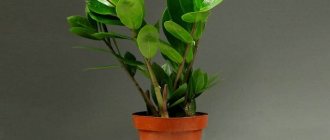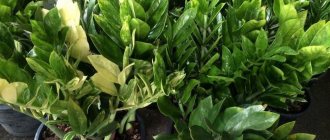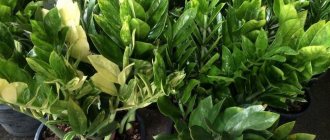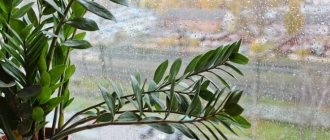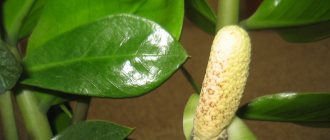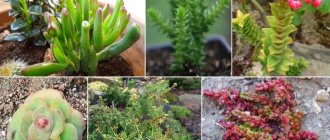The dollar tree is also called Zamioculcas tropicalis. It is bred everywhere. Zamioculcas is one of the representatives of the genus of succulents, so it is absolutely unpretentious in care and can easily get along with any neighbors.
If you care for it correctly, it grows very quickly, grows up to 1.5 meters, and the question of how to transplant a dollar tree immediately becomes relevant. Since each transplant is stressful for most plants, you should not do it too often.
Dollar tree (tropical zamioculcas)
Features of Zamioculcas
Zamioculcas is an evergreen perennial and succulent. Found naturally in the tropical forests of the African continent. In Russia, Zamioculcas is known as the dollar tree.
Breeding and growing the plant does not cause much trouble, so it is actively used in landscaping offices, terraces and loggias. The dollar tree does not look quite ordinary: it does not have a trunk or stems, and what grows from the ground is called a compound leaf and is formed from the root system of the plant (see photo).
But the main feature of the indoor Zamioculcas flower is its ability to accumulate moisture reserves, which it uses during unexpected droughts. If there is no water for a long period, then the plant enters the dormant phase, shedding its leaf blades.
What to do with a flower after purchase
The purchase of a dollar tree is always associated with subsequent replanting. An adult plant must be moved to a new container and placed in a permanent place of growth. Store-bought mixtures stop feeding the flower. Sellers feed these species using the foliar method, without worrying too much about the condition of the soil.
Due to the structural features, adult specimens become cramped in small store containers, which are used to save space. The root system is designed in such a way that the roots, growing on the sides, do not go deep, but remain close to the surface. This makes the flower vulnerable; it is not comfortable in small and unstable plastic pots.
Growing Zamioculcas
Zamioculcas is not a demanding plant, so even a beginner can cope with its cultivation and care. Nevertheless, you need to follow some rules, understand the characteristics of the plant, know its needs and how they are satisfied in natural growing conditions. All this is necessary in order to, when growing zamioculcas in the house, recreate conditions for it that are as close as possible to natural ones.
Caring for a dollar tree at home
Caring for a dollar tree at home involves performing the following procedures:
- maintaining temperature and humidity in the room;
- watering;
- fertilizing;
- garter.
Regular inspection for the presence of pests and diseases and preventive treatment of the plant are also important.
Illumination
One of the important points for caring for zamioculcas is sufficient lighting in the room. Despite the flower's need for sunlight, it should be protected from direct sunlight, especially after watering - the leaves can get burned. In a room where there is not enough light, the leaves become thinner and the flower quickly loses its attractive appearance. The optimal conditions for the plant are light partial shade.
Temperature
Zamioculcas is an unpretentious flower to care for, but it requires compliance with a certain temperature regime, because its appearance and full development depend on this. The optimal temperature in winter is +16...+18 °C, in summer - +22...+28 °C. Temperatures below +12 °C in winter are considered critical, and above +38 °C for the warm season.
Watering
How to water a dollar tree to keep it healthy? The plant does not tolerate excessive moisture and stagnation of water in the pan. Overdrying the soil is unacceptable, since the flower begins to use up internal reserves and will lose its upper leaves. It is necessary to water Zamioculcas as soon as the soil dries out after the last moistening, and the water should be at room temperature.
Air humidity
The flower does not require high humidity, it does not need irrigation, since it is adapted to growing in dry climates. Moreover, dry air is better for this plant than humid air. It is enough to wipe each sheet with a damp cloth as needed to remove accumulated dust.
Bloom
Zamioculcas flowering is a rare phenomenon even in its natural habitat. If the culture develops in comfortable conditions, then sometimes this happens, but only with a plant at least 2–3 years old.
You can make Zamioculcas bloom if you create favorable growing conditions for it.
Fertilizers
The plant must be fed periodically to stimulate the growth and development of the flower. It is important to combine fertilizer application with watering. The procedure must be performed once a week. The exception is the dormant period of the plant. The answer to the question of how to feed zamioculcas is very simple: complex store-bought fertilizers for succulents.
Garter
How to care for a dollar tree throughout the life of the plant? Adult specimens often reach 1 m in height, so there comes a time when they need support. The best solution is to use a wooden or plastic ring. Otherwise, the plant will fall apart and some branches will break off.
Zamioculcas transplant
The first transplant will be required almost immediately after purchasing the plant. As soon as Zamioculcas adapts to new conditions, it should be planted in a new pot, changing the soil. Next, the flower is replanted as the root system grows and develops. On average, this needs to be done once every 2–4 years.
During the procedure, you should try not to injure the roots, as they are very fragile and sensitive. The soil needs to be loose, nutritious, with neutral acidity. You can cook it yourself. The following components will be required in equal parts:
- peat;
- coarse sand;
- leaf and turf soil.
You should choose a strong, stable pot, since the flower grows large. With each transplant, the capacity should be larger than the previous one.
Choosing a pot
When choosing the right pot for growing zamioculcas, you should take into account the characteristics of the plant's root system. Having strong roots, the dollar tree can easily break through a plastic pot as it grows. The advantage of plastic containers is that it is much easier to break it and free the plant without damaging its roots.
Clay and ceramic pots are more suitable for growing large plants due to their greater stability and weight. Natural materials also have good thermoregulation, retaining heat in cold rooms and not warming up in the sun. Therefore, the dollar tree will feel better in a spacious container made of clay or ceramics. Plastic should only be chosen for growing young plants, as a temporary shelter.
Please note that the new pot should be 3-4 cm deeper and wider than its predecessor, and there must be holes at the bottom to drain excess liquid. Before planting the plant, fill it a quarter full with a layer of drainage.
Depending on the age of the flower, drainage materials may vary. For young plants up to 3 years old, polystyrene foam can be used. Older zamioculcas should be planted in pots filled with pebbles or expanded clay. This will make the container more stable. Regardless of the type of drainage, it should be covered with a thick layer of sand.
Rest period
The dollar tree is distinguished by its need for a long period of dormancy. It must be arranged from mid-autumn to early spring. To do this, move the pot to a cool, well-lit room. The recommended temperature is 16-18 degrees. It is required to maintain it at the same level. The plant is watered less frequently, approximately once every 20-30 days. Applying fertilizers during this period is strictly prohibited, since then the dollar tree will not be able to rest and will direct all remaining energy to useless growth.
Time for transfer
It is better to replant zamioculcas for the first time no later than two weeks after purchase. But there are cases when the plant has already properly settled down at home and has adapted well to home conditions. In this case, it should be replanted in the warm season - in May or summer. For an adult flower, planting in a new pot can only be done after the flowering period has ended.
Important! The succulent blooms infrequently, delighting its owner with interesting flowers of an original shape.
dollar tree flower
Young zamioculcas need to be replanted as often as possible to give them the opportunity to grow properly, showing their full power and the beauty of dark green glossy fleshy leaves.
Reproduction
You can propagate a dollar tree in several ways:
- dividing the bush;
- cuttings;
- propagation by leaf blade.
When cuttings, the first root will appear after 1–2 months, and a full-fledged plant can be obtained after 7–8 months.
How to plant zamioculcas using the method of dividing a bush? First of all, the roots are carefully separated from each other, and then each part is planted in the ground as an independent plant and watered very sparingly.
Leaf propagation is the simplest and most accessible method, however, a full-fledged plant will form only after 6–7 months. Each of these methods has its own advantages. Let's take a closer look at them.
Cuttings
The most popular way to get a mini dollar tree specimen. To do this, you only need a good cutting from a mature plant and suitable soil: steamed substrate without humus, fine sand, sphagnum or coconut fiber. You also need to prepare small pots for seedlings or ordinary plastic cups. The main thing is that there are holes in the container to drain the liquid.
However, you need to remember that zamioculcas leaves germinate very slowly: the tuber and roots form in 2–3 months, and you will have to wait up to six months for the first leaves.
The procedure is as follows:
- Cut the zamioculcas leaf at the base and use a sharp knife to carefully divide it into cuttings along the internodes. The correct cutting has 1–2 leaves and a whole leaf node.
- Treat the cut parts with a slurry of activated carbon and water and dry.
- After drying, plant the cuttings in the ground with the bottom of the leaf node.
- Watering is not required for the first two days, then moderate soil moisture is recommended. Along with watering, it is necessary to spray the cuttings with water.
Dollar tree cuttings can be rooted not only in soil, but also in water. In this case, it is much easier to control the rooting process.
- A cutting 7–10 cm in length is cut from the top of the leaf and cleared of the lower leaves, leaving 2–3 at the top.
- The future tree is immersed in a transparent container and filled halfway with water. It is necessary to maintain the fluid level and add it from time to time.
- The roots are fully formed in 2–3 months, after which the plant is transplanted into the ground.
How to grow Zamioculcas from a leaf
Only healthy, large and well-developed leaf blades of adult plants are suitable for propagating a dollar tree using leaves: they contain a sufficient amount of nutrients that allow the new plant to take root and take root.
To propagate Zamioculcas with leaves, follow our instructions:
- Cut off the leaf blade with a sharp knife.
- Treat it with Kornevin or any similar substance that stimulates root formation. Dry the sheet for 2-3 hours.
- Bury the plant 1/3 of the way into moist, loose soil.
- Water regularly but sparingly. It is important not to allow the soil to dry out or stagnate water.
The average period for the formation of the root system is 2 months.
By dividing the tuber
This is the fastest way to propagate zamioculcas, but you should carefully select the material for transplantation: only fully formed specimens with several new growth points on the surface of the earth are suitable.
To successfully divide a plant, you need:
- Carefully and carefully remove the plant from the pot and shake off the roots from the ground.
- Identify parts of the plant that can be separated. They must have their own tuber, roots and a rosette with several leaves.
- Using a sharp knife, divide the root system, trying to make as few unnecessary movements as possible.
- Treat the sections with activated carbon and leave to dry.
- Then plant new plants in separate containers and water.
Which pot should you choose?
Choosing a flowerpot is an important issue, because the comfort of the plant and the development of its root system depend on it. If the time has come for replanting, then do not take sudden steps, but buy a pot that is only a couple of centimeters larger in diameter than the previous one.
Keep in mind! A flowerpot that is too large will slow down the growth of leaves and the entire surface part of the zamioculcas, because the ground part of the flower begins to develop only after the root system has grown and the entire volume of the substrate has been mastered.
The tree is very picky about the shape of the pot. The ideal option would be a wide flowerpot with a narrowed lower part.
The flowerpot should have holes at the bottom through which excess liquid can escape during watering.
It is impossible to give clear advice regarding the material, because there are always risks.
Plastic containers are easily transformed by the influence of roots, and clay flowerpots can limit development and lead to the death of the tree. When choosing the lesser evil, stop, of course, on plastic - it can be easily cut and replaced. It won't be that easy to deal with ceramics.
Diseases and pests
Zamioculcas is susceptible to attacks by the following insects:
- scale insect;
- aphid;
- spider mite;
- mealybugs;
- thrips.
Having discovered parasites, you should review the care: watering regime, adjust the humidity and temperature in the room where the tree is grown. As a preventative measure, it is necessary to frequently inspect the plant, and at the first sign of an insect attack, use specialized preparations.
Zamioculcas is susceptible to some diseases, including root rot, the appearance of dark spots, and yellowing of leaves. The causes of diseases also lie in improper care.
Varieties of Zamioculcas
The most famous varieties of flowers include:
- Zamioculcas zamifolia;
- Zamioculcas lanceolate;
- Zamioculcas variegata;
- Zamioculcas variegated.
They differ from each other in the shape and shade of the leaf plates, as well as in density and size.
Zamioculcas zamifolia
The most common representative of the plant. The bush reaches 70–90 cm in height, has bright green leathery leaves with fleshy petioles.
Popular varieties:
- "Lucky", or round-leaved zamioculcas. Its bright green leaves have a regular circle shape. It grows no more than half a meter in height. This variety develops faster than others.
- "Zamikro". Low-growing hybrid (no more than 60–70 cm in height). The leaves are small, no more than 5 cm.
- "Black Raven" reaches a height of 75 cm. Mature leaves are dark green in color and appear black from a distance. Young leaves stand out against their background with their light green color. Grows well in the shade without changing color.
Zamioculcas lanceolata
This type of dollar tree has an unusual elongated lanceolate leaf shape. Its only representative with the same name is a small bush up to 30 cm high.
Zamioculcas variegata
This species is easily recognized by the specific marbled color of its leaves. Adult specimens grow up to 1.5 in height. It is rarely found on sale. Many plants can only be found through collectors.
Popular varieties:
- 'Long Leave' has long, dark green leaves with lemon-colored stripes of varying widths. Leaf petioles grow up to 80 cm in length.
- "Short Liv" is distinguished by bright white inclusions and stripes on the leaf blades. The petioles are short, green or white-green with a purple tint. The leaves do not exceed 10 cm in length and grow close to each other. This variety grows no more than half a meter in height.
- "Big Leaves" stands out with its rich yellow color, so bright that it seems that the plant is about to shed its leaves. The leaf petioles are pale green in color, with a purple tint.
Possible mistakes
The dollar tree is considered a hardy plant. This unpretentious perennial is resistant to diseases and pests. However, with improper care, various problems can arise. When growing zamioculcas, it is important to systematically moisten the soil, not to injure the roots, and adhere to the watering regime.
The appearance of yellowness on leaf blades is not always a problem. Against the backdrop of slow growth of the crop, some leaves become old, turn yellow and fall off. In this case, there is no need to worry. After all, in place of the fallen ones, new ones necessarily grow. However, the sheets may also turn yellow due to:
- systematic drafts;
- sudden temperature change;
- overdried soil;
- pest invasions.
The gardener needs to periodically inspect his flowers, which will allow him to quickly identify and eliminate the cause of the disease. A healthy perennial will be able to delight with its decorative appearance throughout the year.
Keeping a dollar tree at home is becoming prestigious. Following the recommendations for proper plant care will allow you to grow a gorgeous plant. The most important thing is to systematically moisten the soil, apply fertilizing and place flower pots in a place well lit by sunlight.
